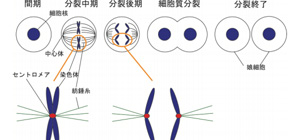
Mechanism of how genes are passed on to next generation clarified
Will lead to the development of anti-cancer agents for preventing abnormal gene transmission
Genetic transmission to the next generation is essential for maintaining life. Genes are transmitted through chromosomes from one generation to the next; however, abnormalities that occur in transmission make a cell cancerous. Therefore, research to clarify the mechanism of how chromosomes correctly pass on genes from one generation to the next is very important because it may lead to the development of methods for inhibiting canceration. Research clarified that centromeres, molecular devices on chromosomes, were important for transmission of genes and chromosomes, but how centromeres were formed was unknown.
A group of researchers led by Professor FUKAGAWA Tatsuo, Graduate School of Frontier Biosciences, Osaka University, clarified the mechanism behind formation of centromeres, molecular devices that play an important role in transmitting genes to descendants.
This group conducted research focusing on the RbAp48 protein by using human and chicken cells, clarifying that centromeres were formed through a modification of the CENP-A protein by RbAp48, a world first.
In this study, the group clarified that CENP-A and histone H4 made CENP-A complex and that led to formation of centromeres through acetylation of histone H4 mediated by the RbAp48 complex.
Histone modifications do not occur without RbAp48, so CENP-A deposition into centromeres is compromised, which does not induce formation of centromeres, molecular devices necessary for transmitting genes, resulting in cell death. This shows that modifications of the CENP-A complex by RbAp48 is necessary for formation of centromeres.
This group’s study results will lead to the development of anti-cancer agents for cancer prevention. If it becomes possible to adjust formation of centromeres by controlling the function of RbAp48 as well as strengthening or weakening modifications of CENP-A complex, it will be possible to specifically kill cancer cells.
Abstract
Centromeres are specified epigenetically through the deposition of the centromere-specific histone H3 variant CENP-A. However, how additional epigenetic features are involved in centromere specification is unknown. Here, we find that histone H4 Lys5 and Lys12 acetylation (H4K5ac and H4K12ac) primarily occur within the pre-nucleosomal CENP-A–H4–HJURP (CENP-A chaperone) complex, before centromere deposition. We show that H4K5ac and H4K12ac are mediated by the RbAp46/48–Hat1 complex and that RbAp48-deficient DT40 cells fail to recruit HJURP to centromeres and do not incorporate new CENP-A at centromeres. However, C-terminally-truncated HJURP, that does not bind CENP-A, does localize to centromeres in RbAp48-deficient cells. Acetylation-dead H4 mutations cause mis-localization of the CENP-A–H4 complex to non-centromeric chromatin. Crucially, CENP-A with acetylation-mimetic H4 was assembled specifically into centromeres even in RbAp48-deficient DT40 cells. We conclude that H4K5ac and H4K12ac, mediated by RbAp46/48, facilitates efficient CENP-A deposition into centromeres.
Figure 1
Figure 2
To learn more about this research, please view the full research report entitled “ Acetylation of histone H4 Lysine 5 and 12 is required for CENP-A deposition into centromeres ” at this page of the Schizophrenia Research website.
Related link
